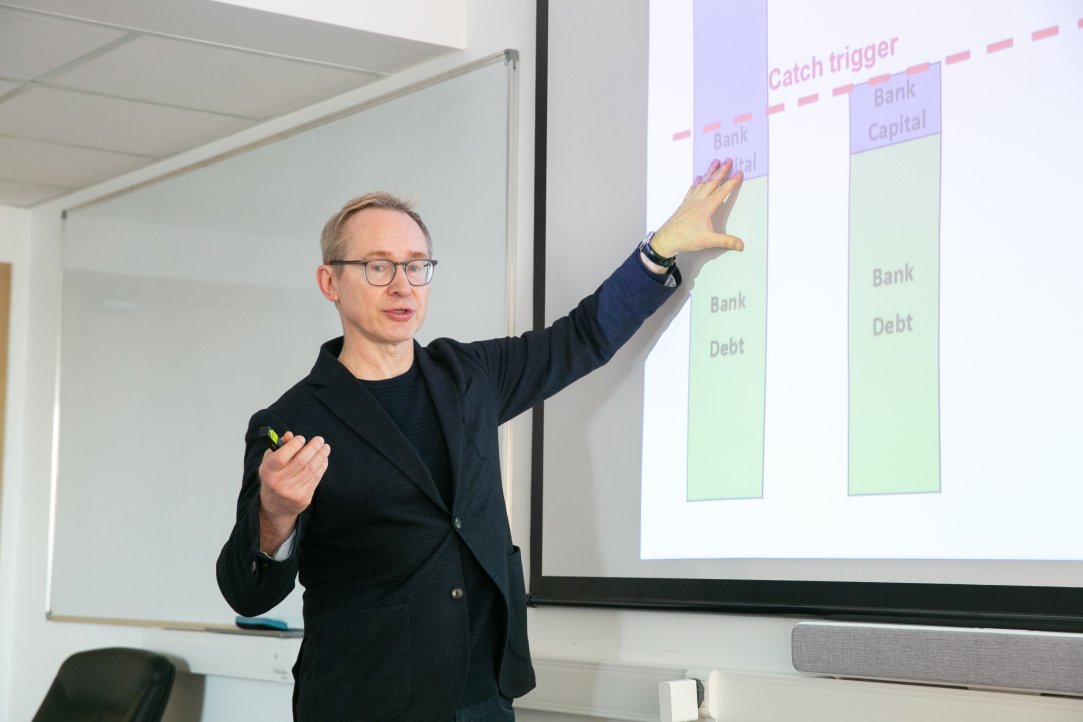Professor Sergey Tsyplakov Gave Bank Bailouts Talk to ICEF Students

Professor Sergey Tsyplakov of University of South Carolina Moore School of Business (USA) has recently hosted the ICEF student research seminar and met with college faculty. Professor Tsyplakov also contributed to HSE Аpril Conference and did a talk about federal intervention strategies that helps banks to avoid bankruptcy.
Bank Bailouts was the topic chosen for the mentor’s seminar by Sergey Tsyplakov. A newly started series of learning activities, this mentor’s seminar has been the first in this academic year and is delivered as a roundtable for first-year master’s students and those of undergraduates who would like to increase their awareness of current economic and financial issues under the guidance of invited experts. Participation in the mentor’s seminar involves preparing for the discussion by reading the materials provided by the mentor. At the seminar, the mentor gives brief overview and moderates ensuing discussion. The participating students are expected to present, and give grounds for, their point of view.
Professor Tsyplakov’s seminar discussed the banking regulation in the United States, spanning the period from the crisis of 2007 until presently. Specifics as to how the bank bailout strategies are administered and how small a bank’s capital should be in order to qualify as being close to falling and requiring interference, etc. were addressed in the context of the current U.S. banking crisis, arousing particular interest among the students.
This has been the second talk Professor Tsyplakov gave to ICEF students during this academic year. In the fall of 2022 he contributed to ICEF-CInSt International Moscow Finance Conference as a keynote speaker. In his early days as a researcher, Sergey studied capital asset management models, risk management and corporate hedging under stochastic volatility. Prof. Tsyplakov’s current research is focused on corporate and banking bankruptcy and involves the input from empirical researchers, the latter kindly providing him with empirical data and testing models that he builds.
For the last five years, Professor Tsyplakov has been conducting studies into the U.S. financial bailouts. One detailed account of the banking regulator actions is provided in the paper Catch, Restrict, and Release: The Real Story of Bank Bailouts. Sergey produces studies that the regulators use as basis for elaborating bank support programmes and default prevention strategies. In 2018, his paper Bank Bailouts, Bail-ins, or Bankruptcy? A Dynamic Model and Empirical Tests of Optimal Regulatory Design landed the award from Southern Finance Association (SFA) as a paper of remarkable value for financial institutions and economy at large. “We should be aware that our papers get read not only by our colleagues but also people on Wall Street. We must therefore be aware of the consequences our published research may entail,” says Professor Tsyplakov.
Bank bailouts are not “one-shot” events as portrayed in theoretical and empirical literature, but dynamic processes with multiple phases over time. Regulators first “catch” financially-distressed banks and provide financial assistance, then “restrict” banks’ activities for an ex-ante unknown lengths of time until eventual “release” when banks reach sufficiently healthy standards. Together with his co-authors, Sergey designs the principles for socially-optimizing regulators to conduct bailouts in a dynamic model in which banks manage capital in anticipation of bailouts. In his tests, Sergey uses hand-collected data for EU bank bailouts, finding that regulators act in qualitatively consistent fashion with model predictions for social optimization.
In his presentation, Professor Tsyplakov focused on the structure of the U.S. banking system and the actions taken by the government to deal with potential economic defaults. He then gave a step-by-step account of regulators’ decisions concerning particular banks, mentioning also those banks’ reaction to the restrictions imposed, perceived risk levels, and capitalization guarantees that are provided to banks as part of the reforms undertaken by the regulators. In this process, one major challenge before the regulators is to reconcile the interests on the financial and the social side. Sergey cited as example Orderly Liquidation Authority (OLA), designed to replace bankruptcies for affected financial institutions. One of Sergey’s main points is that bank bailouts are a complex, time-consuming but predictable process, for it depends on the decisions of the regulator and the response actions of the banks. For instance, “curing” a bank in Europe takes approximately two years, during which time various restrictions are imposed, with regulators monitoring the recovery using a step-wise approach to the “release” of operations until sufficient stability is reached.
Sergey presented his own models for calculating the effectiveness of the bank-regulator interaction, providing also cases of investor response to restrictions. The presented models aroused questions among the student audience, mostly as to how reliability of calculations and forecasts is achieved in them. The presentation was followed by discussion in which students gave ideas and opinions that sounded non-trivial to the host himself. Professor Tsyplakov noted the students’ high level of awareness and interest in learning more about the issues at the confluence of theoretical finance and business.